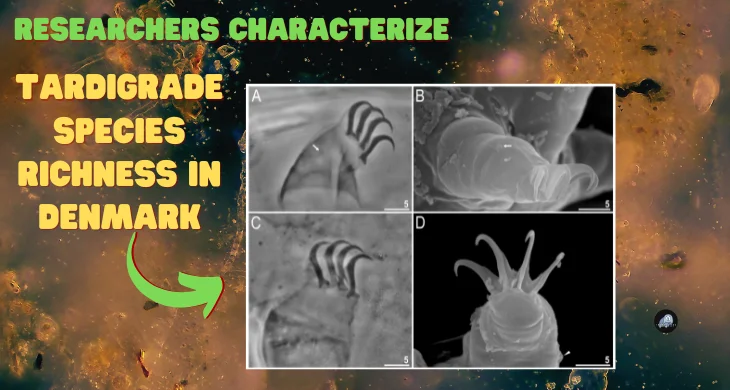In a comprehensive endeavor, researchers have delved into Denmark’s ecosystems to examine and characterize the species richness of tardigrades. This investigation offers insights into the diversity and distribution of these microscopic organisms within the region’s varied habitats.
Diverse Ecosystem Exploration
In a comprehensive endeavor, researchers embarked on an extensive exploration of diverse ecosystems across Denmark. Their study spanned a range of habitats, encompassing soil, leaf litter, and freshwater environments. By venturing into these varied landscapes, scientists sought to uncover the hidden biodiversity of tardigrades, microscopic organisms with unique survival abilities. This thorough investigation not only sheds light on the distribution of tardigrade species but also underscores the importance of comprehensively understanding the intricate relationships between these organisms and their specific ecological niches within the Danish landscape.
Microscopic Marvels
The study centered on the captivating world of tardigrades, minuscule organisms celebrated for their exceptional resilience. Tardigrades, often referred to as “water bears” or “moss piglets,” were chosen as the study’s focal point due to their intriguing ecological significance. Renowned for their ability to survive extreme conditions through cryptobiosis, these microscopic marvels play crucial roles within ecosystems. By examining these remarkable creatures, researchers aimed to unravel the intricacies of their interactions, shedding light on the essential functions they perform and contributing to a deeper understanding of the complex web of life in the environments they inhabit.
Methodology
The research methodology encompassed systematic sample collection from diverse Danish habitats. This process involved gathering specimens from soil, leaf litter, and freshwater environments, capturing the range of potential tardigrade habitats. Subsequent analysis employed meticulous techniques, including advanced microscopy to identify and observe the microscopic organisms, and DNA sequencing to delve into their genetic makeup. This multi-faceted approach allowed researchers to not only document the presence of tardigrades but also delve into their genetic diversity, aiding in species identification and providing insights into their role within the intricate tapestry of Denmark’s ecosystems.
Species Discovery
The study yielded a fascinating revelation by unveiling a rich spectrum of tardigrade species thriving within Denmark’s diverse environments. Through meticulous exploration of various habitats, Ranging from soil to aquatic ecosystems, Researchers unearthed an array of previously undiscovered or lesser-known species. This discovery underscores the remarkable adaptability of tardigrades, Enabling them to inhabit and flourish in a wide array of ecological niches. By shedding light on this diverse range of species, the study contributes to our understanding of the intricate biodiversity within Denmark, reflecting the resilience & tenacity of these microscopic organisms across the nation’s varied landscapes.
Distribution Insights
The process of identifying & classifying tardigrade species yielded valuable insights into their distribution & abundance patterns across different habitats within Denmark. Researchers were able to map out where specific species were most prevalent & where they exhibited variations in abundance. This comprehensive assessment provides a clearer picture of how tardigrades occupy & adapt to varying ecological conditions. Understanding their distribution sheds light on their roles within ecosystems & contributes to our broader understanding of how these microscopic organisms interact with & contribute to the delicate balance of life in Denmark’s diverse landscapes.
Local Biodiversity
The findings of this research offer a window into Denmark’s rich tapestry of biodiversity, specifically highlighting the often overlooked realm of microscopic life. By delving into the diversity of tardigrade species. The study provides a lens through which we can appreciate the intricacies of local ecosystems. These minuscule organisms with their unique adaptations & roles, contribute to the intricate web of life that defines Denmark’s varied habitats. Ultimately, this research underscores the importance of studying both the visible & the hidden components of biodiversity to achieve a comprehensive understanding of the natural world & the myriad forms of life it supports.
Ecological Significance
Comprehending the roles that tardigrades fulfill within local ecosystems provides valuable insights into their ecological significance & intricate interactions. As microscopic organisms with unique survival abilities, tardigrades influence nutrient cycling, decomposition, & microbial communities. By unravelling their contributions to these processes, researchers gain a deeper understanding of the delicate balance that sustains ecosystems. These insights have far-reaching implications, shedding light on how these often-overlooked organisms contribute to the health & functioning of their environments. Moreover, this understanding contributes to broader ecological knowledge, enriching our grasp of the complex web of life and its interdependencies within Denmark’s ecosystems.
FAQ’s
Q1: What was the goal of the research on tardigrade species richness in Denmark?
A1: The research aimed to examine and characterize the diversity of tardigrade species present in various habitats across Denmark.
Q2: What are tardigrades, and why are they of interest to researchers?
A2: Tardigrades are microscopic organisms known for their resilience and adaptability. Researchers study them to understand their ecological roles and survival strategies.
Q3: How did researchers conduct the study of tardigrade species richness in Denmark?
A3: Researchers collected samples from different ecosystems in Denmark and analyzed them using techniques like microscopy and DNA sequencing to identify and classify tardigrade species.
Q4: What did the research reveal about tardigrade diversity in Denmark?
A4: The research unveiled the range of tardigrade species present in Denmark, providing insights into their distribution, abundance, and potential ecological significance.
Conclusion
In conclusion, the research endeavor focused on characterizing tardigrade species richness in Denmark has provided valuable insights into the diversity and distribution of these remarkable microscopic organisms. By systematically studying various habitats within the region, researchers have shed light on the multitude of tardigrade species thriving in Denmark’s ecosystems. This newfound understanding not only contributes to our knowledge of local biodiversity but also has implications for broader ecological studies. As we continue to unravel the intricacies of these fascinating creatures. The research serves as a testament to the importance of exploring the hidden corners of our world to uncover the secrets of its smallest inhabitants.

